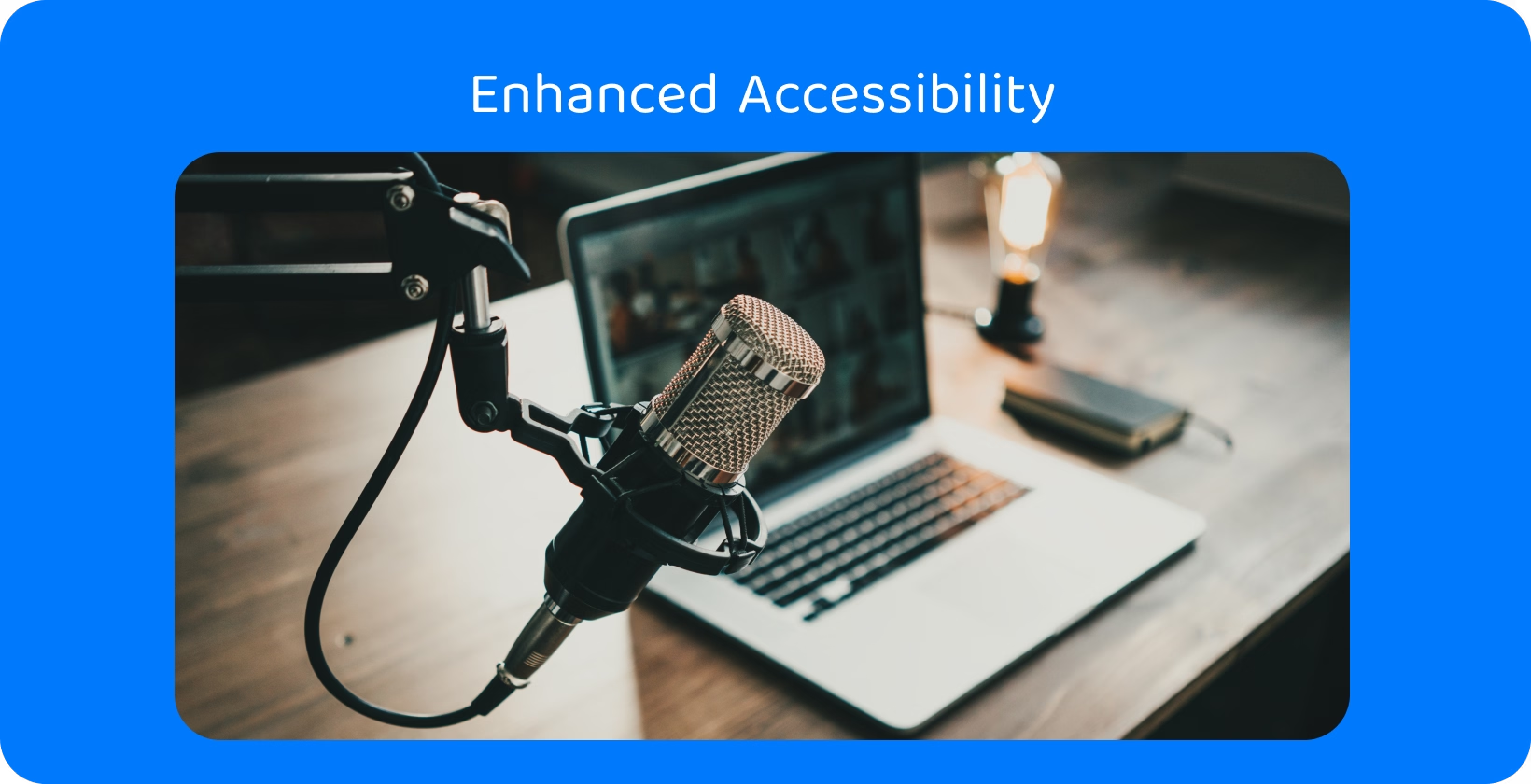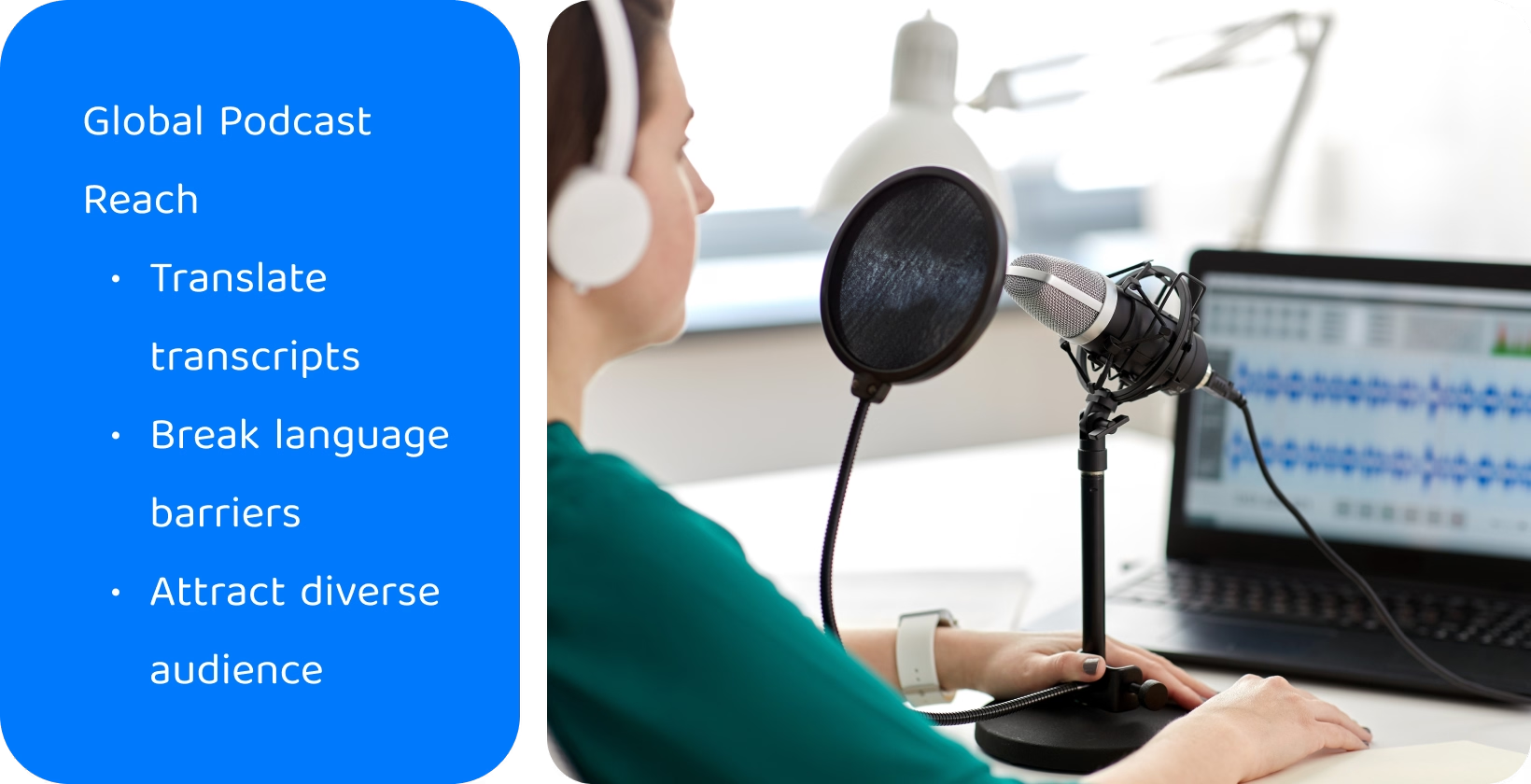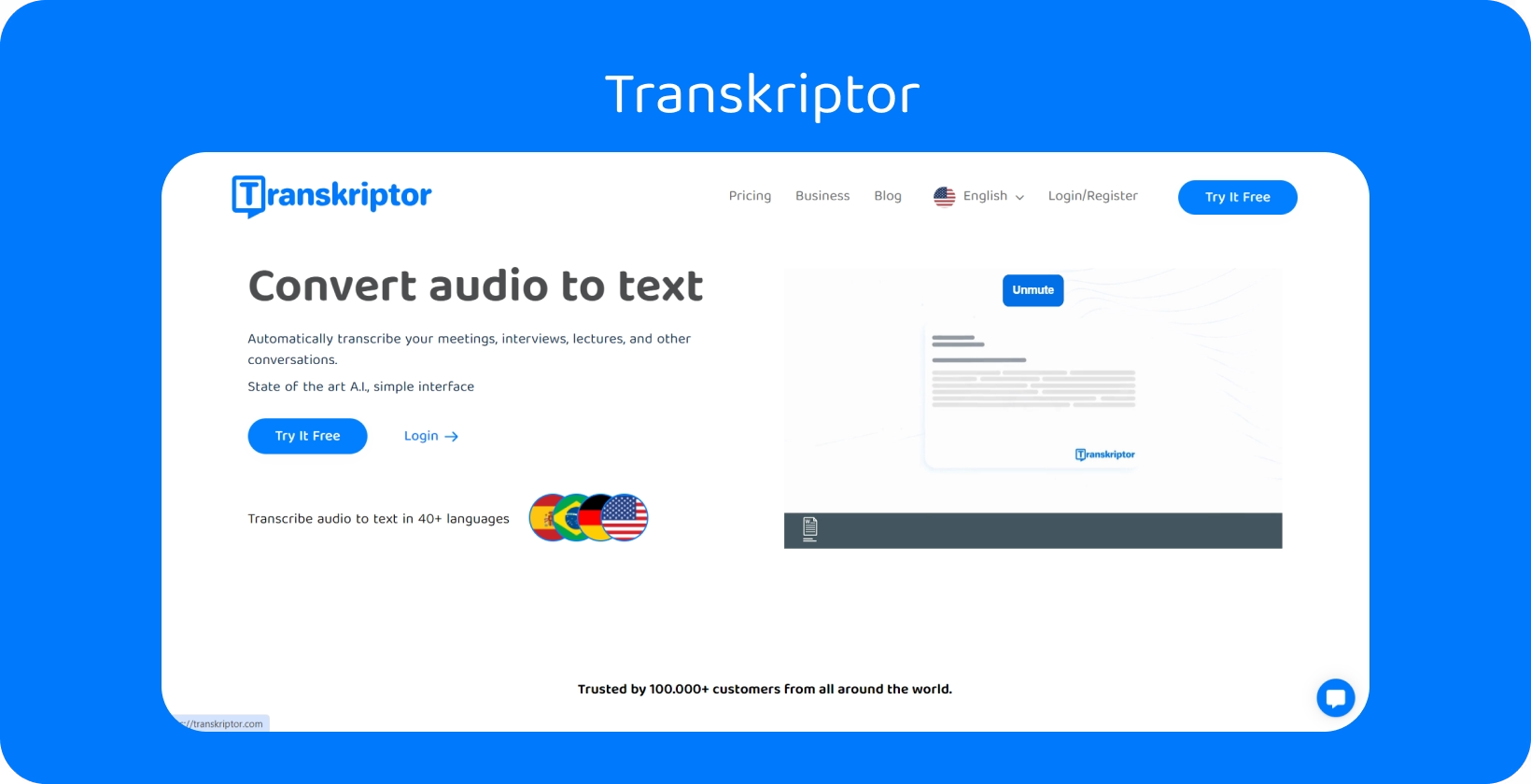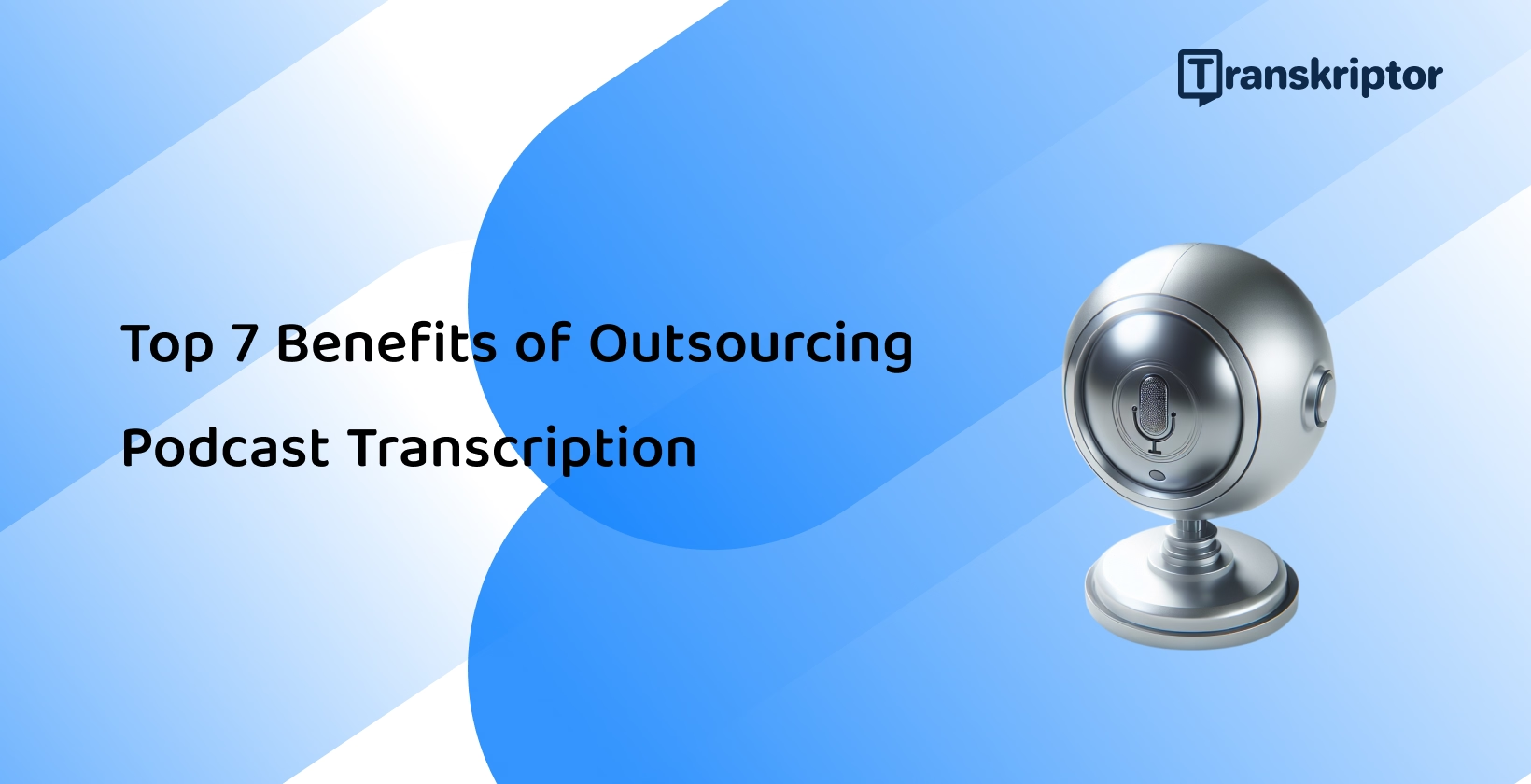The advantages of podcast transcription services are substantial, from saving time and resources to enhancing accessibility and SEO optimization. Fortunately, Transkriptor, with its efficient and reliable transcription services , effectively addresses the primary challenge podcasters face, ensuring seamless audio content conversion into text.
The top 7 benefits of podcast transcription services are listed below.
- Enhanced Accessibility: Transcripts make podcasts accessible to deaf and hard-of-hearing individuals and non-native English speakers.
- Improved SEO: Transcribing content improves SEO, increasing podcast visibility across platforms.
- Time Savings: Outsourcing transcription saves time, allowing focus on podcast creation and promotion.
- Quality Assurance: Professional transcription ensures accurate, credible content.
- Content Repurposing: Editors are able to repurpose podcasts into blogs, articles, and social media posts, expanding content reach.
- Global Reach: Translated transcripts reach diverse international audiences, fostering a global community.
- Legal Compliance: Transcripts aid legal compliance and document podcast-related issues, ensuring transparency.

1. Enhanced Accessibility
Transcripts play a pivotal role in enhancing accessibility to podcast content, catering to a diverse audience. They provide an alternative means of consuming audio content for users with hearing impairments, ensuring inclusivity and equal access to information.
Transcripts also significantly benefit non-native English speakers, as they are able to follow along more effectively, improving their comprehension and engagement with the podcast material.
Moreover, transcripts facilitate easier navigation and reference, allowing users to locate specific segments or information within the podcast quickly. This accessibility feature is particularly valuable for individuals who prefer reading or have limited time to listen to lengthy audio recordings.
Transcripts contribute to making podcast content more searchable and discoverable, enhancing its overall visibility and reach across various platforms. The accessibility afforded by transcripts fosters greater engagement and participation in podcast discussions and knowledge sharing from educational institutions to businesses and beyond.
2. Improved SEO
Creators provide text content for search engines to index by transcribing podcasts, which significantly increases their podcasts' visibility and overall ranking in search engines. Moreover, services like Transkriptor provide accurate and reliable transcription that adheres to SEO best practices.
Transcriptions serve as valuable text content that search engine algorithms are able to crawl and index, increasing the likelihood of podcasts appearing in relevant search results. This increased visibility makes it easier for users to attract new listeners actively searching for the topics covered in their podcasts.
Additionally, transcriptions offer opportunities for users to incorporate relevant keywords and phrases naturally into their content, further optimizing their SEO efforts. Users are able to improve their search engine rankings and reach a more targeted audience by strategically including keywords related to their podcast niche or topics discussed.
Transcriptions also allow users to repurpose their podcast content across platforms and channels, expanding their online presence and strengthening their SEO strategies. Users usually use transcription to diversify their content and reach a broader audience, such as blog posts, social media snippets, or articles based on podcast episodes. Try Transkriptor today !
3. Time Savings
Outsourcing podcast transcription saves users significant time savings, enabling them to allocate their resources more efficiently. Users are able to streamline their workflow and focus on core activities such as content creation and strategic planning by delegating the transcription task to external services like Transkriptor.
They no longer need to spend hours manually transcribing podcast episodes, as outsourcing allows them to leverage professional transcriptionists with the expertise and tools to deliver accurate and timely transcriptions.
Also, outsourcing transcription ensures quick turnaround times, enabling users to receive transcriptions promptly without sacrificing quality. This efficiency is particularly beneficial for users who produce regular podcast episodes and need transcriptions delivered promptly to maintain their publishing schedule.
4. Quality Assurance
Users benefit from outsourcing podcast transcription due to the assurance of quality provided by professional transcribers.
Professional transcribers guarantee precise and high-quality transcriptions, unlike automated transcription services, which are able to produce inaccurate or error-prone transcripts (one of the drawbacks of podcast transcription services).
Users usually rely on expertise and attention to detail to deliver accurate transcripts by entrusting tasks to experienced professionals. This ensures that the final transcripts are of the highest standard and free from errors commonly associated with automated transcription services.
Professional transcribers possess the necessary linguistic skills and subject matter expertise to transcribe podcast episodes across various topics and industries accurately. They understand the importance of maintaining consistency in terminology, punctuation, and formatting, ensuring the final transcripts are coherent and easy to read.
Moreover, outsourcing transcription to professionals allows users to leverage quality assurance processes and protocols implemented by reputable transcription services like Transkriptor.
These processes typically involve multiple rounds of review and proofreading to ensure the accuracy and completeness of the transcripts before they are delivered to the users.
5. Content Repurposing
Users are able to leverage outsourced podcast transcription to facilitate content repurposing, unlocking numerous opportunities to extend the reach and impact of their podcast content. Transcripts are a valuable source of written content that should be repurposed into various formats, such as blog posts, articles, and social media content.
Users gain access to accurate and comprehensive transcripts that capture the essence of their podcast episodes by outsourcing audio transcription tasks to services like Transkriptor. These transcripts provide users with a wealth of material that are able to be repackaged and repurposed to cater to different audience preferences and consumption habits.
For instance, users are able to transform podcast transcripts into long-form blog posts or articles, diving deeper into the topics discussed and offering additional insights and analysis. This enhances the SEO value of their website and provides valuable content for their audience to engage with outside of the podcast format.
Users are able to extract key quotes, excerpts, or insights from podcast transcripts to create bite-sized social media posts, graphics, or videos. These snippets are able to be shared across various social media platforms to drive engagement, spark discussions, and attract new listeners to their podcast.
Users are able to repurpose podcast transcripts into downloadable resources such as e-books, guides, or whitepapers, further establishing their authority and expertise in their respective niches.

6. Global Reach
Users benefit from outsourcing podcast transcription services as it facilitates translations of transcripts, enabling podcasts to reach a more diverse, international audience. Podcasters are able to effectively engage with listeners worldwide, fostering a global community of followers by offering transcripts in multiple languages.
Translations of transcripts break down language barriers, allowing users from different linguistic backgrounds to access and enjoy podcast content in their native languages.
Thus, podcasts will attract new listeners from various regions and demographics, increasing their visibility and relevance in the global media landscape. This expanded reach enhances audience engagement and opens up opportunities for partnerships, collaborations, and monetization strategies on a global scale.
7. Legal Compliance
Outsourcing podcast transcription services helps users maintain legal compliance by providing accurate transcripts that serve as documentation for podcast-related matters.
Having transcripts readily available ensures transparency and accountability, enabling users to demonstrate compliance with relevant laws, regulations, and industry standards. Transcripts are crucial in fulfilling legal obligations, whether adhering to copyright laws, ensuring accuracy in disclosures, or meeting accessibility requirements.
Professional transcription services ensure that transcripts are produced with precision and attention to detail, reducing the risk of legal disputes from inaccuracies or omissions in podcast content and other disadvantages of podcast transcription services.
Users are able to rely on certified transcribers to accurately capture spoken words, ensuring that the content aligns with legal standards and requirements.

How to Get Podcast Transcription Easily with Transkriptor?
Follow the steps to get podcast transcription with Transkriptor.
- Step 1: Sign Up or Log In: Begin by visiting the Transkriptor website. Here, you have the choice to either create a new account by signing up or log into your existing account if you already have one.
- Step 2: Upload Your Podcast File: Click on the upload section to select your podcast file from your device. Make sure the file is in a format that Transkriptor supports for transcription.
- Step 3: Configure Transcription Settings: After uploading your file, select the primary language of the podcast. You may also encounter advanced settings to further customize the transcription process, such as speaker identification.
- Step 4: Initiate the Transcription Process: With your file uploaded and settings in place, click the "Transcribe" button to commence the transcription. The processing time will depend on the file's length.
- Step 5: Review and Edit Your Transcript: Access the completed transcription from your dashboard. Transkriptor allows you to review and edit the transcript for any inaccuracies, ensuring the final text matches your expectations.
- Step 6: Export and Use Your Transcript: Finally, select an export format for your transcript, such as TXT, DOCX, or PDF. Download the transcript to your device, ready for sharing, archiving, or any other use you have planned.
Ready to experience the convenience of automated podcast transcription? Sign up for a trial with Transkriptor today and streamline your workflow!
How Popular Are Podcasts?
Podcasts have become popular worldwide, with millions of active shows and a growing audience across diverse demographics. Users from various backgrounds and interests turn to podcasts as a preferred medium for information, entertainment, and education.
Podcasts' convenience and flexibility contribute to their widespread adoption. Users are able to listen to podcasts anytime, anywhere, whether during their daily commute, while exercising, or while relaxing at home. This accessibility factor has led to a surge in podcast consumption, attracting users who seek on-the-go entertainment or valuable insights during their daily routines.
The diversity of podcast genres caters to a wide range of user preferences, from comedy and true crime to business and self-improvement. There is a podcast for virtually every interest, making it easy for users to find content that resonates with them.
The proliferation of smartphones and streaming platforms has further fueled the popularity of podcasts. Users are able to access a vast library of podcasts with just a few taps on their mobile devices, eliminating the need for specialized equipment or subscriptions.
What Types of Podcast Transcription Services Are Available?
Users have access to a variety of types of podcast transcription services tailored to their specific needs and preferences. These services typically fall into three categories: automated, human-based, and hybrid models.
Automated transcription services utilize advanced speech recognition technology to automatically transcribe podcast audio into text. Users benefit from the speed and cost-effectiveness of automated solutions, as transcripts are generated quickly and with minimal human intervention.
However, automated transcriptions are able to lack accuracy (one of the drawbacks of podcast transcription services), particularly in cases of complex audio or accents.
Human-based transcription services involve professional transcribers who manually listen to podcast episodes and transcribe them into text. These services prioritize accuracy and quality, ensuring that transcripts are error-free and reflect the nuances of spoken language.
Human-based services are able to take longer and incur higher costs than automated solutions. Still, they offer superior accuracy, making them ideal for users who require precise transcriptions for professional or academic purposes.
Hybrid models combine automated technology with human oversight to deliver accurate and efficient transcription services. Automated algorithms generate initial transcriptions, which are then reviewed and edited by human transcribers to correct any errors and ensure quality.
This approach combines the benefits of both types of podcast transcription services: the speed of automated transcription and the accuracy of human intervention, providing users with reliable transcripts on time.
Is Outsourcing Podcast Transcription Cost-Effective?
Outsourcing podcast transcription is a cost-effective solution for users seeking accurate and timely transcriptions without the burden of extensive in-house resources. Users are able to streamline their workflow by leveraging professional transcription services, saving valuable time and effort.
Outsourcing eliminates the need to invest in specialized software or hire dedicated transcription staff, reducing upfront costs and ongoing expenses. Instead, users are able to opt for flexible payment models offered by transcription service providers, such as pay-per-minute or subscription-based plans, which allow for cost-effective scalability based on individual needs. Outsourcing ensures the accuracy and quality of transcriptions, minimizing the risk of errors that arise from relying on automated transcription tools or inexperienced staff.
Professional transcribers possess the expertise and attention to detail necessary to produce precise transcripts, ultimately saving users from the potential costs associated with inaccuracies or revisions.
Outsourcing podcast transcription frees up internal resources, enabling users to focus on core tasks such as content creation, marketing, and audience engagement. This reallocation of resources maximizes productivity and efficiency, ultimately contributing to the overall cost-effectiveness of outsourcing.
Transkriptor for Accurate Podcast Transcription
Transkriptor is a powerful tool for accurate podcast transcription, offering users rapid and precise audio conversion to text .
This feature significantly enhances content accessibility and improves SEO, ultimately increasing podcasts' reach and visibility. Transkriptor saves users valuable time by automating the transcription process, allowing them to focus on creating and refining their content.
One of Transkriptor's standout features is its ability to handle multiple languages, catering to diverse audiences and broadening the appeal of podcasts on a global scale. Transkriptor ensures accurate transcription across various linguistic nuances whether users produce content in English, Spanish, French, or other languages.
Transkriptor's intuitive and easy-to-use platform empowers podcasters to manage their transcription needs efficiently. Users are able to upload audio files, monitor transcription progress, and review transcripts with ease with a user-friendly interface and seamless navigation.
This streamlined process enables podcasters to maintain quality standards and ensure effortless compliance with transcription requirements. Experience the efficiency and accuracy firsthand by integrating Transkriptor into your podcast workflow today. Sign up now for a trial and see the difference for yourself!


